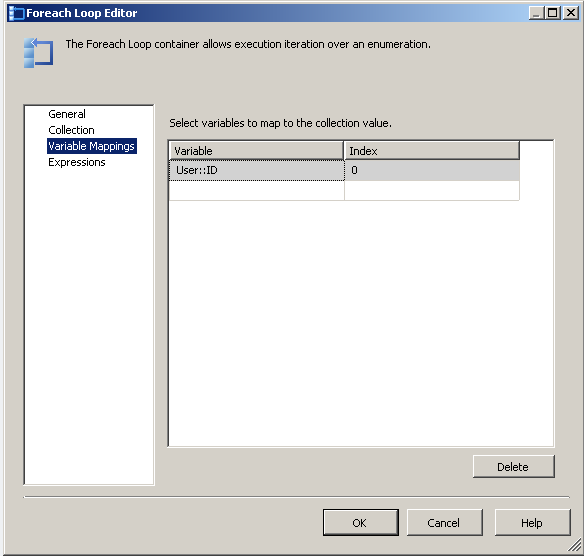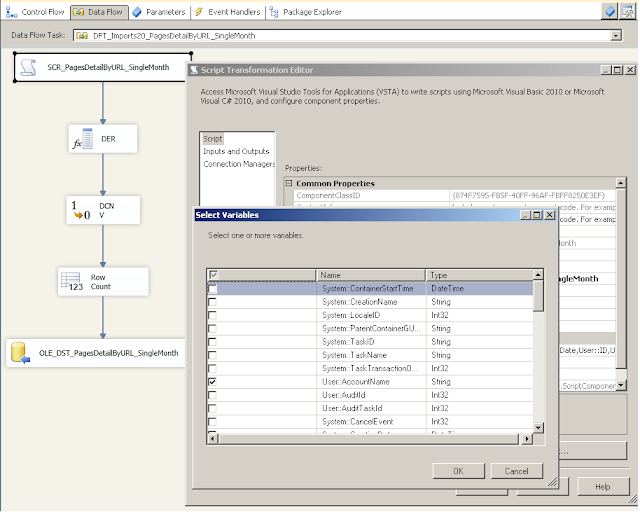Schema to create DateControlMonth
table
Example table and package to retrieve value from Google Analytics for the last completed single month
Below is the example figures for ETL to load data in a table
Created variables:
ControlFlow example:
Below is the script to get FromDate, ToDate, FiscalMonth, FiscalQuarter and FiscalYear those will be passed as parameter in Google Analytics to retrieve data for the particular period. (Last completed month data)
DataFlowTask steps:
We need to select variables to pass in the script component coding area.
Once the output columns created in SCR task, Click on EditScript to go the VisaProjects. In the Solution Explorer screen, Right click on – References – click Add References – Select the DLL file as given in the below figure.
Below is the example figures for ETL to load data in a table
Created variables:
ControlFlow Steps
DataFlowTask steps:
We need to select variables to pass in the script component coding area.
CREATE TABLE [web].[DateControlMonth](
[FiscalYear] [smallint] NULL,
[FiscalQuarter] [tinyint] NULL,
[FiscalMonth] [tinyint] NULL,
[FiscalYearStartDate] [date] NULL,
[FiscalYearEndDate] [date] NULL,
[FiscalMonthStartDate] [date] NULL,
[FiscalMonthEndDate] [date] NULL
)
Script to populate value in
DateControlMonth table
SELECT dd.[FiscalYear]
,dd.FiscalQuarter
,dd.[FiscalMonth]
,(SELECT MIN(DD2.DateValue)
FROM [EDW20].[dbo].DimDate dd2
WHERE dd2.FiscalYear =
DD.FiscalYear) AS [FiscalYearStartDate]
,(SELECT MAX(DD2.DateValue)
FROM [EDW20].[dbo].DimDate dd2
WHERE dd2.FiscalYear =
DD.FiscalYear) AS [FiscalYearEndDate]
,MIN(dd.dateValue)
[FiscalMonthStartDate]
,MAX(dd.dateValue)
[FiscalMonthEndDate]
FROM [EDW20].[dbo].DimDate dd
WHERE FiscalYear > 2005
//provide year to get data from
GROUP BY dd.[FiscalYear]
,dd.FiscalQuarter
,dd.[FiscalMonth]
ORDER BY dd.[FiscalYear]
,dd.FiscalQuarter
,dd.[FiscalMonth]
Schema to create DateControlQuarter
CREATE TABLE
[web].[DateControlQuarter](
[FiscalYear] [smallint] NULL,
[FiscalQuarter] [tinyint] NULL,
[FiscalQuarterStartDate] [date] NULL,
[FiscalQuarterEndDate] [date] NULL
)
Script to populate value in
DateControlQuarter table
SELECT dd.[FiscalYear]
,dd.[FiscalQuarter]
,MIN(dd.dateValue)
[FiscalQuarterStartDate]
,MAX(dd.dateValue)
[FiscalQuarterEndDate]
FROM [EDW20].[dbo].DimDate dd
WHERE FiscalYear > 2005 //provide
year to get data from
GROUP BY dd.[FiscalYear]
,dd.[FiscalQuarter]
ORDER BY dd.[FiscalYear]
,dd.[FiscalQuarter]
Schema to create
SiteprofileHistory_Date
CREATE TABLE
[web].[SiteProfileHistory_Date](
[UniqueId] [int] IDENTITY(1,1) NOT
NULL,
[ProfileId] [varchar](24) NULL,
[FiscalYear] [smallint] NULL,
[FiscalMonth] [tinyint] NULL,
[FiscalQuarter] [tinyint] NULL,
[MonthStartDate] [date] NULL,
[MonthEndDate] [date] NULL,
[QuarterStartDate] [date] NULL,
[QuarterEndDate] [date] NULL,
[YearStartDate] [date] NULL,
[YearEndDate] [date] NULL
)
SSIS-ETL Steps to populate values in SiteprofileHistory_Date
Schema to create
SiteprofileHistoryDate_Quarter
CREATE TABLE
[web].[SiteProfileHistoryDate_Quarter](
[UniqueId] [int]
IDENTITY(1,1) NOT NULL,
[ProfileId]
[varchar](24) NULL,
[FiscalQuarterStartDate]
[date] NULL,
[FiscalQuarterEndDate]
[date] NULL,
[FiscalYear]
[smallint] NULL,
[FiscalQuarter]
[tinyint] NULL
)
Script to populate value in
SiteprofileHistoryDate_Quarter
SELECT DISTINCT
[ProfileId]
,[FiscalYear]
,[FiscalQuarter]
,[QuarterStartDate]
,[QuarterEndDate]
FROM
[web].[SiteProfileHistory_Date]
Schema to create
SiteprofileHistoryDate_FYTD
CREATE TABLE
[web].[SiteProfileHistoryDate_FYTD](
[UniqueId] [int]
IDENTITY(1,1) NOT NULL,
[ProfileId]
[varchar](24) NULL,
[FYTDStartDate]
[date] NULL,
[FYTDEndDate]
[date] NULL,
[FiscalYear]
[smallint] NULL,
[FiscalMonth]
[tinyint] NULL,
[FiscalQuarter]
[tinyint] NULL
)
Script to populate value in
SiteprofileHistoryDate_FYTD
SELECT DISTINCT
[ProfileId]
,[FiscalYear]
,[FiscalMonth]
,[FiscalQuarter]
,[YearStartDate] AS FYTDStarteDate
,[MonthEndDate]
AS FYTDEndDate
FROM
[web].[SiteProfileHistory_Date]
Example table and package to retrieve value from Google Analytics for the last completed single month
Once the date
related tasks have done, we can start with create table for
PageDetailByURL and how to populate value to this table. The
following schema is to create table for PageDetailByURL_SingleMonth
which will load data for the last completed month.
We can also pull
the data for the last completed quarter and FYTD.
CREATE TABLE
[web].[PagesDetailByURL_SingleMonth](
[ProfileID] [int]
NOT NULL,
[Interval]
[varchar](20) NOT NULL,
[FiscalYear]
[smallint] NULL,
[FiscalMonth]
[tinyint] NULL,
[FiscalQuarter]
[tinyint] NULL,
[PageURL]
[nvarchar](max) NULL,
[PageViewCount]
[int] NULL,
[UniquePageViewCount]
[int] NULL,
[AvgTimeOnPage]
[numeric](18, 2) NULL,
[EntranceCount]
[int] NULL,
[BounceRate]
[numeric](18, 2) NULL,
[ExitPercent]
[numeric](18, 2) NULL,
[TotalValue]
[numeric](18, 2) NULL,
[RecordExists]
[bit] NULL,
[AuditTaskId]
[int] NULL
)
Below is the example figures for ETL to load data in a table
Created variables:
ControlFlow example:
Below is the script to get FromDate, ToDate, FiscalMonth, FiscalQuarter and FiscalYear those will be passed as parameter in Google Analytics to retrieve data for the particular period. (Last completed month data)
SELECT ? = DATEADD(mm,
DATEDIFF(m,0,getdate())-1,0)
SELECT ? = DATEADD(s,-1,DATEADD(mm,
DATEDIFF(m,0,getdate()),0))
DECLARE @DATE DATETIME, @Quarter INT
SET @DATE =
(convert(varchar(20),(SELECT DATEADD(mm,
DATEDIFF(m,0,getdate())-1,0)),111))
SET @Quarter = Datepart(QQ,DATEADD(mm,
DATEDIFF(m,0,getdate())-1,0))
SELECT ? = CASE WHEN (MONTH(@Date) >
9) THEN YEAR(@Date) + 1
ELSE YEAR(@Date)
END -- AS FiscalYear
SELECT ?= CASE WHEN (MONTH(@Date) >
9) THEN MONTH(@Date) - 9
ELSE MONTH(@Date)
+ 3 END -- AS FiscalMonth
SELECT ?= (SELECT DISTINCT
FiscalQuarter FROM DimDate WHERE QuarterNumber = @Quarter)
Note: we
need DimDate table to bring fiscal quarter
DataFlowTask steps:
We need to select variables to pass in the script component coding area.
Once the output columns created in SCR task, Click on EditScript to go the VisaProjects. In the Solution Explorer screen, Right click on – References – click Add References – Select the DLL file as given in the below figure.
In the main.cs file, write the below coding.
#region Help:
Introduction to the Script Component
/* The Script
Component allows you to perform virtually any operation that can be
accomplished in
* a .Net
application within the context of an Integration Services data flow.
*
* Expand the
other regions which have "Help" prefixes for examples of
specific ways to use
* Integration
Services features within this script component. */
#endregion
#region Namespaces
using System;
using System.Data;
using
Microsoft.SqlServer.Dts.Pipeline.Wrapper;
using
Microsoft.SqlServer.Dts.Runtime.Wrapper;
using
System.Windows.Forms;
using
GoogleAnalyticsSupport;
#endregion
.................
.................etc,.
.................etc,.
public
override void CreateNewOutputRows()
{
ReportRequestorWithSorting RR = new ReportRequestorWithSorting();
RR.Email =
Variables.UserName; //"test_googleanalytics@mycompany.org";
RR.Password = Variables.Password; // "abcdefgh";
DateTime
value =Variables.FromDate; //new DateTime(2010, 9, 1);
DateTime
value1 = Variables.ToDate; //new DateTime(2012, 9, 26);
AnalyticsAccountInfo AAI = new AnalyticsAccountInfo();
AAI.AccountName = Variables.AccountName; //"myaccount";
AAI.WebPropertyID = Variables.WebPropertyId;
//"http://myaccount.abcd.com";
AAI.ProfileID = Convert.ToString(Variables.ProfileID); // "123456";
AAI.ID =
Variables.ID; // "ga:123456";
AAI.Title
= Variables.Title; // "myaccount.abcd.com";
var
PagesDetailByURL = RR.ReportRequestWF(AAI, new Dimension[] {
Dimension.pagePath }
,new
Metric[7]{Metric.pageviews,Metric.uniquePageviews
,Metric.avgTimeOnPage,Metric.entrances,Metric.visitBounceRate,Metric.exitRate
,Metric.totalValue},new Sort[]{Sort.pageviews},value, value1);
foreach
(var p in PagesDetailByURL)
{
Output0Buffer.AddRow();
Output0Buffer.PageURL = p.Dimensions[0].Value.ToString();
Output0Buffer.PageViewCount = p.Metrics[0].Value.ToString();
Output0Buffer.UniquePageViewCount = p.Metrics[1].Value.ToString();
Output0Buffer.AvgTimeOnPage = p.Metrics[2].Value.ToString();
Output0Buffer.EntranceCount = p.Metrics[3].Value.ToString();
Output0Buffer.BounceRate = p.Metrics[4].Value.ToString();
Output0Buffer.ExitPercent = p.Metrics[5].Value.ToString();
Output0Buffer.TotalValue = p.Metrics[6].Value.ToString();
Output0Buffer.SiteProfileID = AAI.ProfileID.ToString();
}
}
}
Example table and package to retrieve data from the inception date of Google Analytics
The following
schema is to create table for PageDetailByURLHistory_SingleMonth
which will load data for the from the inception date to the last
completed month.
We can also pull
the data for the quarter and FYTD.
CREATE TABLE
[web].[PagesDetailByURLHistory_SingleMonth](
[ProfileID] [int]
NOT NULL,
[Interval]
[varchar](20) NULL,
[FiscalYear]
[smallint] NULL,
[FiscalMonth]
[tinyint] NULL,
[FiscalQuarter]
[tinyint] NULL,
[PageURL]
[nvarchar](max) NULL,
[PageViewCount]
[int] NULL,
[UniquePageViewCount]
[int] NULL,
[AvgTimeOnPage]
[numeric](18, 2) NULL,
[EntranceCount]
[int] NULL,
[BounceRate]
[numeric](18, 2) NULL,
[ExitPercent]
[numeric](18, 2) NULL,
[TotalValue]
[numeric](18, 2) NULL,
[RecordExists]
[bit] NULL,
[AuditTaskId]
[int] NULL
)
Below is the example figures for ETL to load data in a table
Created variables:
ControlFlow Steps
DataFlowTask steps:
We need to select variables to pass in the script component coding area.
Once the output
columns created in SCR task, Click on EditScript to go the
VisaProjects. In the Solution
Explorer screen, Right click on – References – click Add
References – Select the DLL file as given in the below figure.
In the main.cs file, write the below coding.
#region Help:
Introduction to the Script Component
/* The Script
Component allows you to perform virtually any operation that can be
accomplished in
* a .Net
application within the context of an Integration Services data flow.
*
* Expand the
other regions which have "Help" prefixes for examples of
specific ways to use
* Integration
Services features within this script component. */
#endregion
#region Namespaces
using System;
using System.Data;
using
Microsoft.SqlServer.Dts.Pipeline.Wrapper;
using
Microsoft.SqlServer.Dts.Runtime.Wrapper;
using
System.Windows.Forms;
using
GoogleAnalyticsSupport;
#endregion
.............................
....................etc,.
....................etc,.
public
override void CreateNewOutputRows()
{
ReportRequestorWithSorting RR = new ReportRequestorWithSorting();
RR.Email =
Variables.UserName; //"test_googleanalytics@mycompany.org";
RR.Password = Variables.Password; // "abcdef";
DateTime
value =Variables.FromDate; //new DateTime(2010, 9, 1);
DateTime
value1 = Variables.ToDate; //new DateTime(2012, 9, 26);
AnalyticsAccountInfo AAI = new AnalyticsAccountInfo();
AAI.AccountName = Variables.AccountName; //"myaccount";
AAI.WebPropertyID = Variables.WebPropertyId;
//"http://myaccount.abcd.com";
AAI.ProfileID = Convert.ToString(Variables.ProfileID); // "12345";
AAI.ID =
Variables.ID; // "ga:12345";
AAI.Title
= Variables.Title; // "myaccount.abcd.com";
int
fiscalYear = Variables.FiscalYear;
int
fiscalMonth = Variables.FiscalMonth;
int
fiscalQuarter = Variables.FiscalQuarter;
var
PagesDetailByURL = RR.ReportRequestWF(AAI, new Dimension[] {
Dimension.pagePath }
,new
Metric[7]{Metric.pageviews,Metric.uniquePageviews
,Metric.avgTimeOnPage,Metric.entrances,Metric.visitBounceRate,Metric.exitRate
,Metric.totalValue},new Sort[]{Sort.pageviews},value, value1);
foreach
(var p in PagesDetailByURL)
{
Output0Buffer.AddRow();
Output0Buffer.PageURL = p.Dimensions[0].Value.ToString();
Output0Buffer.PageViewCount = p.Metrics[0].Value.ToString();
Output0Buffer.UniquePageViewCount = p.Metrics[1].Value.ToString();
Output0Buffer.AvgTimeOnPage = p.Metrics[2].Value.ToString();
Output0Buffer.EntranceCount = p.Metrics[3].Value.ToString();
Output0Buffer.BounceRate = p.Metrics[4].Value.ToString();
Output0Buffer.ExitPercent = p.Metrics[5].Value.ToString();
Output0Buffer.TotalValue = p.Metrics[6].Value.ToString();
Output0Buffer.SiteProfileID = AAI.ProfileID.ToString();
Output0Buffer.FiscalMonth = fiscalMonth;
Output0Buffer.FiscalYear = fiscalYear;
Output0Buffer.FiscalQuarter = fiscalQuarter;
}
}
}
Creating Delay function using script component task where there is an issue in network. Can set the sleep timing according to the requirement.
public void Main()
{
// TODO: Add
your code here
System.Threading.Thread.Sleep(9000);
Dts.TaskResult
= (int)ScriptResults.Success;
}
































No comments:
Post a Comment
Note: Only a member of this blog may post a comment.